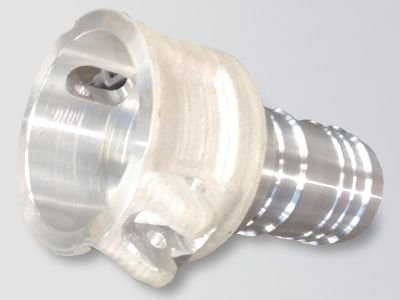How to Specify Additively Manufactured Aluminum Parts

Specifying “Additively Manufactured” (AM) aluminum is challenging and involves an approach guided by ASTM and ISO standards that require more engineering decisions throughout the manufacturing process than typically encountered with a purchased component. With this additional complexity, ISO/ASTM 52910 guides a designer to first establish the general AM potential of the part, which involves material, build size, and a host of feature trade-offs. Next, the designer must select from several AM processes that can provide a range of properties for a given material.
Additive manufacturing processes for metals
- Powder Bed Fusion (PBF)
With Powder Bed Fusion, a 3D part is manufactured one layer at a time using a fine powder as the print medium. This powder is sintered or melted with either a laser or an electron beam as the heat source.
- Directed Energy Deposition (DED)
In the directed energy deposition process (DED), aluminum wire or powders can be melted through focused thermal energy.
- Binder Jetting Processes
Binder jetting allows a host of available MIM powders to be sintered in a furnace after deposition. Several hybrid processes are now developing plastic filaments containing metal that can be deposited through extrusion or jetting processes.
- Cold Spray (CS)
Cold spray has been introduced to build aluminum parts without melting the metal powder, and instead relying on the impact force of metal powder. The powder is accelerated to supersonic speeds and directed to create a shape with a computer-controlled stage or robot
Additive materials utilize unique aluminum alloys
Unique aluminum alloys are available for the powder bed fusion process (PBF) that don’t directly correspond to typical aluminum classes: AlSi10Mg, AlSi12, AlSi7Mg0.6, AlSi9Cu3.
ASTM has established standards for several commonly used materials in powder bed fusion AM systems, however, there are currently none specific to aluminum. Following the example set for stainless steel through ASTM F3184-16, specification involves many decisions that must be agreed between the supplier and the purchaser.
The central element is a detailed manufacturing plan that involves items critical to the feedstock, machine, build process, personnel process, post-processing, and inspection requirements. Due to the nature of PBF systems, every machine produces a unique thermal history on the part constructed and even minor changes in calibration can require a full requalification of the process.
Consider the cold spray alternative
In contrast to PBF, cold spray appears compelling as the aluminum is not melted, therefore the alloy chemistry stays consistent throughout the part. However, even when chemistry is consistent, mechanical properties are reduced due to incomplete bonding — but are more resilient than melting/cooling processes and very good at producing consistent part properties.
Care must be taken in understanding the chemical and mechanical differences as a cold-sprayed 6061 powder produces mechanical properties that align with a cast 356-T6 and behaves nothing like a typical sheet/plate 6061-T6. This can be useful in applications such as the cam and groove coupling SPEE3D used by the Australian Royal Navy for saltwater applications.
Replacing existing 356-T6 castings that corroded to failure, the cold spray additively manufactured part matches pressure test requirements, as well as inhibits corrosion with the 6061 chemistry, thus extending the life of these parts that are printed on a just-in-time basis. The resulting product under MIL-A-21280, high-strength aluminum alloy casting, would be similar to a Class 11 or 12 A356-T6. However, since the chemistry is 6061 and not 356, this part cannot be qualified under the specification.
Physicals: UTS=32ksi, YSI-28ksi min., Elongation=4% min.
Chemicals: Si=.4-.8, Mg=.8-1.2, Cu=.14-.4, Cr=.04-.35, Fe<.7, Mn<.15, Ti<.15, Zn=.25, Al=balance
The importance of post-processing
Post-processing is critical on nearly all additively manufactured metal parts. However, there are no standard designations, and these must become specifically qualified processes established between the supplier and the purchaser.
PBF processes typically suffer from porosity and surface cracking that often require peening and hot isostatic pressing (HIP) processes to reach target properties, and may contain un-bonded powder in hard-to-clean passages.
DED processes typically require significant stress-relieving processes. Plus, with distortion, rough surfaces, and imprecise geometry, forging or machining operations are often required. Cold Spray is typically a dense, but brittle structure as sprayed; and aluminum is processed with a T6 solution heat- treat-with-aging to relax the work hardening and plastic deformation that particles undergo on impact. Machining is typically required with all metal AM processes to ensure critical dimensions.
ISO/ASTM 52910 is the first step
Specifying aluminum in an additive manufacturing process involves detailed quality audit-like procedures, coupled with extensive engineering analysis and testing, for every part produced. There are no standard designations that can be relied upon for parts from an AM supplier, and purchaser must be involved in tests throughout the supply chain that they may not be familiar with. This drives cost and uncertainty into procurement, so following ISO/ASTM 52910 is a good start for determining if you really should pursue an additively manufactured metal part.
For test samples or more information, contact Bruce Colter at bruce.colter@spee3d.com or Doug Wetzel at doug@protomatic.com
About the author: Doug Wetzel is Vice President and General Manager of Protomatic. Protomatic is a CNC precision machining shop specializing in prototype and short-run production components for the medical, aerospace and other technical industries. Because of the critical nature of the parts they design and manufacture, the emphasis is always on Life-Saving Precision.



